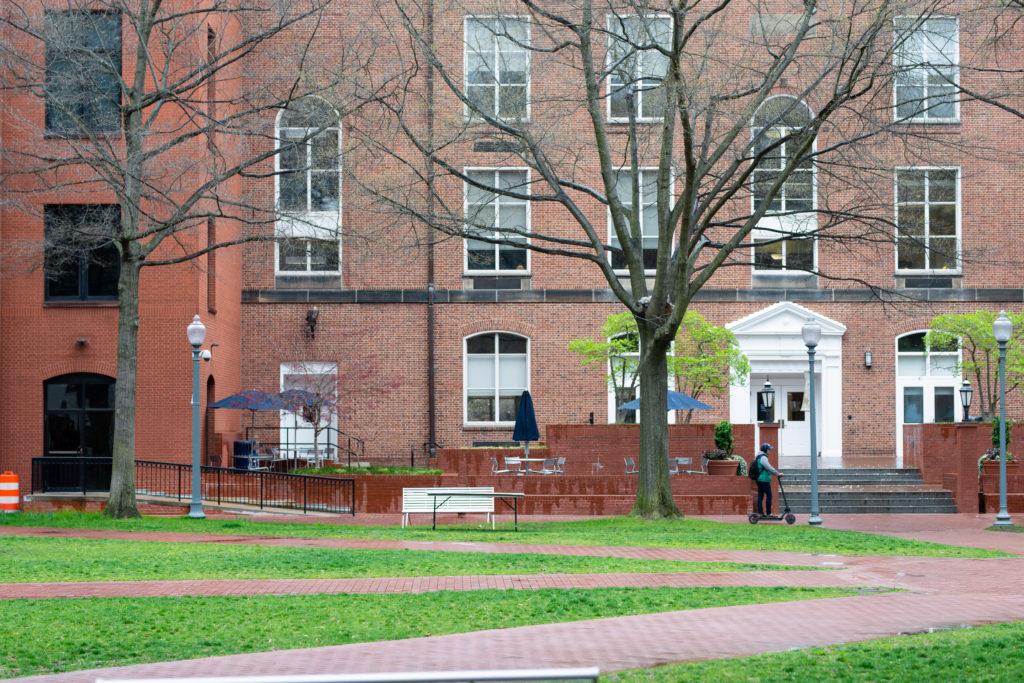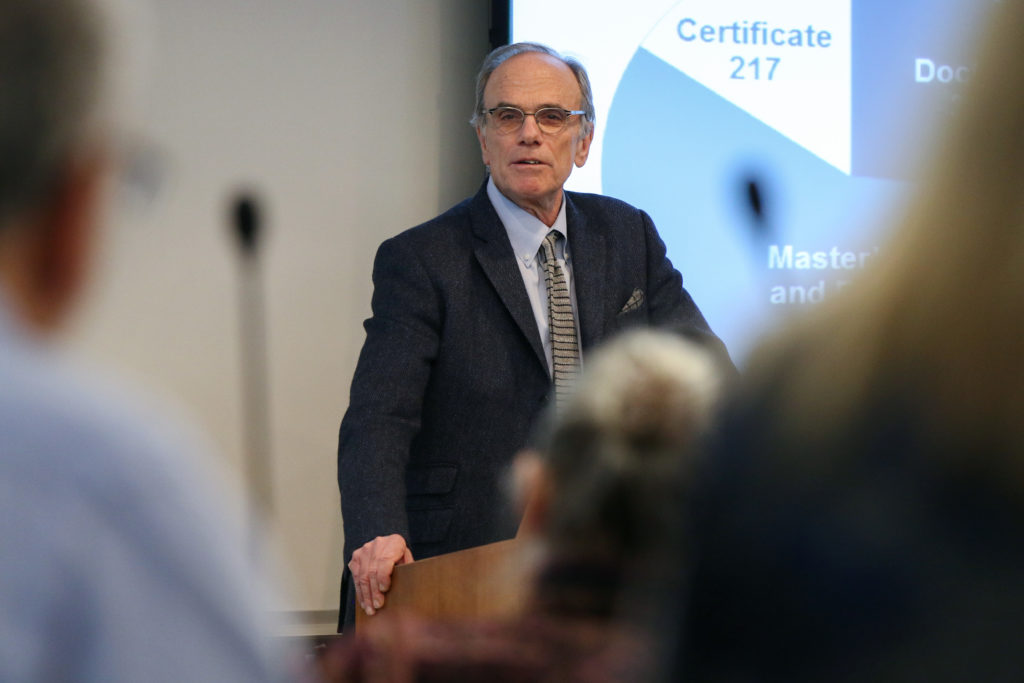One year ago, officials issued letters of acceptance to the Class of 2025 as the University apprehensively made plans to return to in-person learning after months of virtual operations.
Today, almost two years after D.C.’s first pandemic-related stay-at-home order, GW has returned to some sense of pre-pandemic normalcy. As American and Georgetown universities walk back their mask mandates, ever-changing guidance on health and safety guidelines threaten GW’s ongoing return to pre-pandemic operations.
The Delta and Omicron variants escalated COVID-19 caseloads to a record daily total of 184 in early January, accompanied by constant changes in public health policies like lifted and reinstated mask mandates in the District.
After campus remained empty for about five months during the first peak of the pandemic in spring 2020, officials started to revive campus life when 500 students moved into Shenkman and South halls and District House in the fall 2020 semester. The University upped the number of campus residents to 1,500 during the following semester while the on-campus cohort remained under strict guidelines like daily symptom checks.
Officials announced a plan to gradually reopen campus last summer, holding online summer classes with an in-person component for labs. The COVID-19 vaccine became available to the general public in late March and early April after GW Hospital workers were among the first groups of people in the country receive shots the previous December.
COVID-19 restrictions ebbed as D.C. residents got vaccinated. In May, GW allowed outdoor student gatherings up to 50 people and required on-campus students to receive monthly COVID-19 tests, a decrease from the previous weekly testing regiment. GW lifted its short-lived campus-wide mask mandate for residents who were fully vaccinated in June.
Commencement in May remained online for the second consecutive year, but graduates had reason to be optimistic as officials announced last June that they would hold an in-person ceremony on the National Mall in October for both the classes of 2020 and 2021. In the spring, graduates took photos on campus and hosted small gatherings with newly vaccinated family and friends without in-person ceremonies hosted by the University.
Mayor Muriel Bowser dropped capacity restrictions for restaurants, businesses and community hubs in May, and fully vaccinated people were no longer required to wear a mask indoors – life in the District seemed to be moving closer to “normal.”
But by late July, the Delta variant spread to D.C., driving a five-fold increase in the COVID-19 daily caseload. Bowser reinstated the city’s indoor mask requirement as cases surged in late July, and GW followed suit a day later.
Students complying with the deadline to receive their COVID-19 vaccines returned to campus in late August for the first time in 17 months since the outbreak of the pandemic, and faculty members expressed excitement about teaching in person. Officials required all on-campus individuals to be fully vaccinated, wear a mask indoors and test every 15 days.
Faculty taught classes using new computers, microphones and virtual software to accommodate hybrid learning for students who may test positive throughout the semester. Some professors continued to teach remotely if they lived outside of the DMV or had health concerns preventing them from teaching in person.
Student organizations returned to in-person programming in the fall with community-building events and general body meetings.
But soon after students returned to campus, Delta cases spiked during late August and early September. With campus reaching a 1.14 percent positivity rate on Sept. 7, GW doubled the frequency of its testing requirement, straining its testing facilities.
Despite the increased caseload, GW held its first in-person Commencement ceremony since the start of the pandemic in October to recognize alumni from the classes of 2020 and 2021.
Even as the GW community attempted to return to normalcy, students still struggled to adjust to campus life. With COVID-19 case rates and public health guidelines continuing to fluctuate, officials reported that Counseling and Psychological Services appointments increased, and because of reduced staff and a surge in demand, students struggled to book appointments.
Students also took time to process losses they had suffered throughout the pandemic. Some volunteered to plant hundreds of thousands of white flags on the National Mall to commemorate the lives lost during the pandemic.
A University-wide task force recommended that remote learning remain an option for when students test positive for the virus to uphold a “culture of empathy” in October.
COVID-19 cases began a two-month decline after the September surge in cases. Bowser once again loosened the indoor mask mandate in November, but GW maintained its mask requirement.
Just one month later, the Omicron variant hit D.C., setting off a new series of public health guidelines reminiscent of March 2020.
Daily caseloads skyrocketed with a peak of 102 positive cases on Dec. 15 as students prepared to take final exams. Officials moved exams held after Dec. 16 online and canceled in-person gatherings for the rest of the semester.
They also announced in early December that students would be required to receive a booster dose of the COVID-19 vaccine as public health officials continued to endorse its efficacy in protecting patients from the virus.
Just after the start of winter break, officials announced that classes during the first week of the spring semester would be held virtually.
In preparation for the spring semester, GW tightened its residence hall guest policy, allowing only one guest per resident from the same building, shifted dining to a grab-and-go system and distributed N95 masks for students to use indoors. Many students delayed their return to campus amid health concerns, and Bowser reinstated the public health emergency in January to increase hospital staffing.
Students returned to classes in person in the spring one week later after residential students remained in quarantine until they received two negative PCR tests. The University invested in 250 isolation housing units for the spring, comprising the majority of GW’s pandemic-related spending for the semester.
GW announced in March that tuition would increase by 4 percent, surpassing $80,000 for most undergraduates for the first time next academic year, which officials said was likely due to these increased expenditures.
On-campus restaurants upped prices and struggled to source ingredients as the Omicron variant’s surge caused product and labor shortages during what experts have been calling the “Great Resignation.” The University also saw a pattern of labor shortages on campus, with at least nine University leadership positions that were occupied by interim leaders as of this January.
GW officially returned to full in-person operations at the end of the month, allowing students to attend in-person classes. Faculty prepared to accommodate students through hybrid options and recorded lectures and said they felt safe being back in the classroom.
Once again, cases declined and mandates were lifted. Bowser dropped vaccine and mask requirements in early March.
As the seasons change and students return from spring break, GW’s daily total COVID-19 positivity rate remains near 1 percent, only a slight increase from the rate before spring break, which largely remained just below 1 percent.
As D.C.-area universities continue to lift mask mandates, GW’s requirement remains in place for now. But as officials unveil the speaker for the first in-person spring Commencement since 2019, GW continues to inch closer to normalcy.











